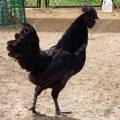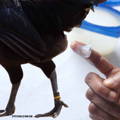
Scaly Leg Mites: Prevention and Treatment
Discover effective treatment options and preventive measures to combat scaly leg mites in backyard chickens. Learn about the causes, symptoms, and lifecycle of these microscopic parasites, and how to keep your flock healthy and mite-free.
FUN FACT: The life cycle of a scaly leg mite is 14-21 days.
Subscribe
To join our mailing list and never miss an update!
Scaly leg mites (KNEMIDOCOPTIASIS) is a common condition that can be a troublesome issue for backyard chicken owners. These tiny parasites, scientifically known as knemidocoptes, burrow beneath the scales on a chicken's legs and feet, causing discomfort and potential long-term damage if left untreated.
However, with proper knowledge and proactive measures, you can effectively manage scaly leg mites and safeguard the well-being of your flock.
In this article, we will delve into the details of what scaly leg mites are, how to treat chickens affected by this condition, and crucial preventive measures to keep your feathered friends mite-free.
FUN FACT: The hexagon shapes that form honeycomb hold the most amount of honey with the smallest amount of beeswax required. Perfect efficiency.
UNDERSTANDING SCALY LEG MITES:
Scaly leg mites are microscopic parasites that infest the legs and feet of chickens. They burrow under the scales, causing them to lift and become crusty, leading to irritation, pain, and potential infection. Mites can spread rapidly among your flock if not addressed promptly.
Three primary species of knemidocoptes, namely K. mutans, K. gallinae, and K. pilae, are known to affect birds, each leading to distinct disease manifestations and clinical signs.
These microscopic mites primarily target unfeathered areas of birds, resulting in the development of scales as a notable clinical sign.

CAUSES OF SCALY LEG MITES:
Scaly leg mites are typically introduced to a flock through contact with infested birds, contaminated equipment, or wild birds. Mites can survive in the environment for several weeks, making it important to implement preventive measures to minimize the risk of infestation.
LIFE CYCLE OF A SCALY LEG MITE:
Understanding the lifecycle of scaly leg mites is crucial for effective treatment and prevention. The mites lay eggs under the scales of the chicken's legs and feet, which hatch into larvae.
These larvae then burrow deeper into the skin and molt into nymphs. The nymphs continue to feed on the chicken's legs and undergo further molting until they mature into adult mites.
The entire lifecycle takes around 2-3 weeks, during which the infestation can worsen if left untreated.
SCALY LEG MITE SYMPTOMS:
Common signs of scaly leg mites include raised and crusty scales, leg swelling, lameness, decreased mobility, and changes in behavior. Regularly inspecting your chickens' legs and feet is crucial to catch the early signs of infestation.
SCALY LEG MITE TREATMENT OPTIONS:
To effectively treat scaly leg mites, a multi-step approach is recommended:
a. Isolate Infested Birds: Separate any chickens showing signs of infestation from the rest of the flock to prevent mites from spreading.
b. Soaking: Soaking the affected legs in warm, soapy water for 15-20 minutes can help soften the scales and ease the removal of mites.
c. Scale Removal: Gently scrub the legs with a soft-bristled toothbrush or cloth to remove the loosened scales. Be cautious not to cause discomfort or injury to the chicken.
d. Topical Treatments: Apply a veterinarian-approved treatment, such as petroleum jelly, vegetable oil, or specialized mite creams, to suffocate and eradicate the mites. Repeat the application for several weeks to ensure complete elimination.
e. Environmental Cleaning: Thoroughly clean and disinfect the coop, perches, and any equipment to eliminate mites that may be present in the environment.
In severe cases of scaly leg mite infestation, veterinary intervention may be necessary. Your veterinarian can prescribe medicated treatments, such as oral or injectable medications, to help eliminate the mites more effectively. It is essential to follow the veterinarian's instructions carefully to ensure the safety and well-being of your chickens.

NATURAL SCALY LEG MITE TREATMENT OPTIONS:
Some chicken owners prefer using natural remedies and supplements to manage scaly leg mites. These may include applying essential oils, such as neem oil or tea tree oil, which have natural insecticidal properties.
The general idea of any scaly leg mite treatment is the suffocation of the mites with whichever application you choose. Remember, a healthy flock is naturally less vulnerable to all pests and diseases.
SCALY LEG MITE PREVENTION MEASURES:
Prevention is key in managing scaly leg mites and maintaining a healthy flock. Here are some preventive measures to implement:
a. Regular Inspections: Routinely inspect all chickens for signs of mites, focusing on their legs, feet, and scales. Early detection allows for prompt treatment and prevents the spread of infestation.
b. Clean Environment: Keep the coop and surrounding areas clean and dry. Regularly remove debris, replace bedding, and sanitize perches and nesting boxes.
c. Provide Dust Baths: Create a designated area with fine dust or sand for chickens to take dust baths. Dusting helps to naturally control mites and other external parasites.
d. Implement Biosecurity Measures: Quarantine new chickens before introducing them to the existing flock. This helps prevent the introduction of mites or other potential diseases.
e. Optimal Nutrition: Maintain a balanced and nutritious diet for your chickens, as healthy birds have a stronger immune system to resist mite infestations.

Trending Products
In addition to the previously mentioned preventive measures, here are a few more tips to further safeguard your flock against scaly leg mites:
• Regularly change and wash bedding material to prevent mites from thriving in damp or soiled environments.
• Provide adequate ventilation in the coop to maintain proper air circulation, as mites thrive in humid and poorly ventilated conditions.
• Consider using diatomaceous earth or PDZ as a preventive measure. Sprinkle it in the coop and around perches to help control mites and other crawling insects.
• Avoid overcrowding in the coop, as overcrowded conditions can contribute to stress and make chickens more vulnerable to infestations.
• Conduct thorough inspections when introducing new birds to your flock. Quarantine them for a few weeks and closely monitor for any signs of mites or other health issues before allowing them to join the main flock.
By incorporating these preventive measures and maintaining a vigilant approach to the health and well-being of your chickens, you can significantly reduce the risk of scaly leg mite infestations and ensure a healthier and happier flock.

THE TAKEAWAY
Copyright©2023 All rights reserved. We love to have you share our article as long as you include a direct link to this page. Please contact us for permission and we’ll be happy to collaborate. This article or any portion thereof , including all images, may not be reproduced or used in any manner whatsoever without the express written permission of Gypsy Shoals Farm.




